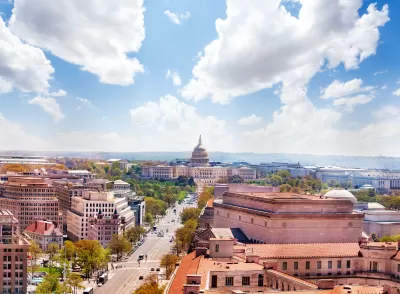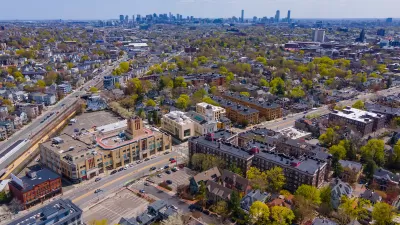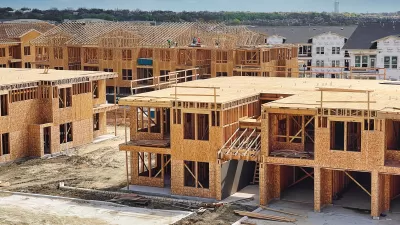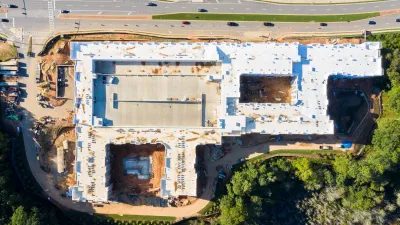The century-old rule has shaped the District’s iconic horizontal skyline, but some Council members say it need revision in light of the region’s growing housing crisis.

The height limit that has long dominated the development of Washington, D.C.’s skyline is coming into question as District leaders seek to bring more housing units and residents to the central core as part of Mayor Bowser’s Comeback Plan. “A key goal of this plan is to ‘add 15,000 residents to the Downtown population by adding seven million square feet of residential units,’” writes Luke Garrett for WTOP.
The Height of Buildings Act, passed in 1910, limits building heights to 90 feet on residential streets and 130 feet on commercial corridors. Now, some District Council members are calling for changes to the century-old act as part of efforts to revitalize the city and adapt to changing housing and office space needs. “The District needs to address its affordable housing crisis through more density, so the Height Act should be on the table for negotiation as a way to increase density and housing units,” said Council member Zachary Parker.
Opponents of changing the Height Act say the District’s flat skyline is a “unique and defining characteristic.” Others call proposed changes to the Height Act a red herring, with Council member Brianne Nadeau saying that “We could double the amount of housing in the city right now if we updated the zoning code, even with the Height Act in place.”
FULL STORY: Why DC’s Height Act may fall this time

Study: Maui’s Plan to Convert Vacation Rentals to Long-Term Housing Could Cause Nearly $1 Billion Economic Loss
The plan would reduce visitor accommodation by 25,% resulting in 1,900 jobs lost.

North Texas Transit Leaders Tout Benefits of TOD for Growing Region
At a summit focused on transit-oriented development, policymakers discussed how North Texas’ expanded light rail system can serve as a tool for economic growth.

Using Old Oil and Gas Wells for Green Energy Storage
Penn State researchers have found that repurposing abandoned oil and gas wells for geothermal-assisted compressed-air energy storage can boost efficiency, reduce environmental risks, and support clean energy and job transitions.

Planting Relief: Tackling Las Vegas Heat One Tree at a Time
Nevada Plants, a Las Vegas-based nonprofit, is combating the city’s extreme urban heat by giving away trees to residents in underserved neighborhoods, promoting shade, sustainability, and community health.

How Madison’s Tree Planting Efforts Are Growing a Healthier Community
Madison’s annual tree planting initiative is enhancing environmental resilience, public health, and community livability by adding 1,400 carefully selected trees citywide, with strong community and institutional support for urban forestry.

Texas State Bills Could Kill Transit Funding in Dallas, Austin
State lawmakers could pull funding from the state’s largest transit agency and the ambitious Project Connect, a voter-approved transit project in Austin.
Urban Design for Planners 1: Software Tools
This six-course series explores essential urban design concepts using open source software and equips planners with the tools they need to participate fully in the urban design process.
Planning for Universal Design
Learn the tools for implementing Universal Design in planning regulations.
Ascent Environmental
Borough of Carlisle
Institute for Housing and Urban Development Studies (IHS)
City of Grandview
Harvard GSD Executive Education
Toledo-Lucas County Plan Commissions
Salt Lake City
NYU Wagner Graduate School of Public Service





























